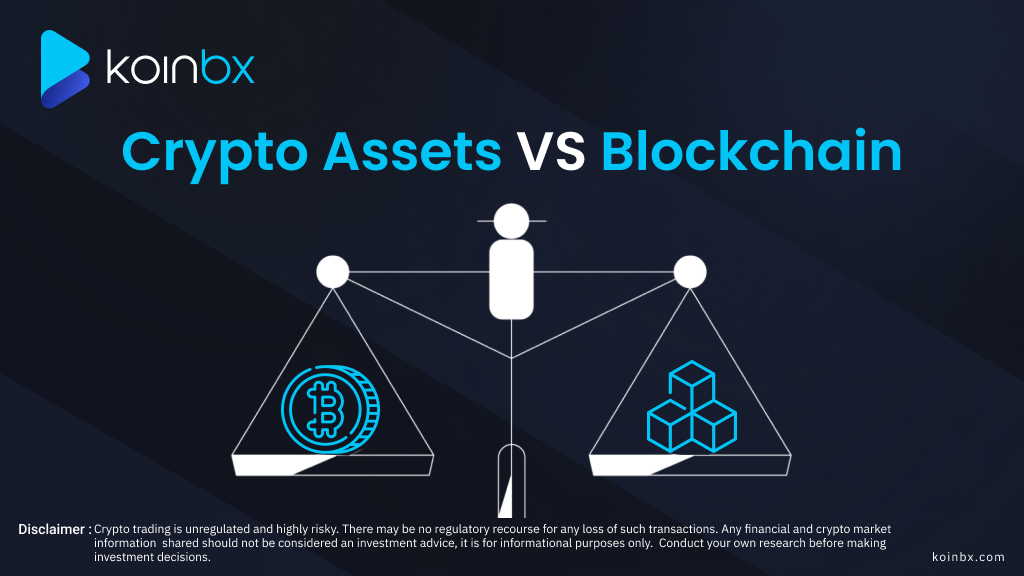If you are new to the crypto space, you have probably heard terms like blockchain and crypto assets thrown around interchangeably. But did you know these two are very different concepts? Both are essential in the digital finance space, but they serve distinct roles. So, if you have ever found yourself confused about the difference between crypto assets and blockchain, we have got you covered! Let’s break it down in a simple way that demystifies these technological terms.
What is Blockchain?
Blockchain is a digital ledger that records and verifies transactions across a decentralized network of computers. This technology ensures transparency and security by publicly recording each transaction. It operates without a central authority, making it the foundation for many applications, including crypto assets and supply chain management.
For example, when you send money to a friend, the blockchain tracks the transaction. Unlike a bank, it does this without a middleman, grouping transactions into blocks and linking them to form a secure chain—hence the name 'blockchain'.
What are Crypto Assets?
Crypto assets are digital currencies or tokens that use blockchain for their existence and operation. They can represent various forms of value, including digital assets such as Bitcoin, utility tokens that grant access to specific services, or security tokens that represent ownership of an asset.
Crypto assets can be traded on exchanges, including centralized exchanges (CEXs), decentralized exchanges (DEXs), and hybrid exchanges, and in other ways, including peer-to-peer (P2P) platforms. They can fluctuate in value based on market demand. Crypto assets offer users an alternative to investment opportunities and financial systems, allowing for peer-to-peer transactions without intermediaries.
How do Blockchain and Crypto Assets Work Together?
Think of blockchain as the highway, and crypto assets as the vehicles travelling on it. Blockchain provides the infrastructure, ensuring that all vehicles or transactions get to their destination securely and transparently. Without the blockchain, crypto assets would not have a safe and tamper-proof system to exist on.
When you transfer Bitcoin or buy an NFT, it is the blockchain that verifies, records, and finalizes that transaction. Crypto assets rely on this decentralized ledger to maintain trust among users. Without blockchain, crypto assets would have no framework to function on.
This synergy allows for a decentralized financial system where users can transact directly without relying on banks or other institutions.
Also read: Centralized Exchanges vs. Decentralized Exchanges: Understanding the difference
Similarities Between Blockchain and Crypto Assets
Though blockchain and crypto assets are different, they share a few common traits. Here’s how they overlap:
Decentralization: Neither blockchain nor crypto assets depend on any central authority (like banks or governments). Both of them operate on decentralized networks, reducing the need for intermediaries.
Security: Both are extremely secure. Blockchain ensures the integrity of data, while crypto assets use cryptography to protect transactions.
Transparency: Blockchain’s open ledger system ensures that all crypto asset transactions are visible and verifiable.
Innovation: Both are disrupting traditional finance and industries, making way for new methods of transferring value and data.
Also read: Spot vs Futures Trading: Which is Right for You?
Differences Between Blockchain and Crypto Assets
Now, let’s highlight what sets blockchain and crypto assets apart:
Purpose: Blockchain is the technology that powers a wide range of applications beyond crypto assets, including supply chain management, voting systems, and digital identities. Crypto assets, on the other hand, specifically refer to the digital tokens or coins used in financial transactions.
Functionality: Blockchain serves as a decentralized, secure database, while crypto assets represent digital value within that database.
Scope: Blockchain is much broader than crypto assets. You can use blockchain for non-financial purposes too, such as storing medical records or tracking shipments. Crypto assets, by contrast, are mainly used for buying, selling, and trading in the digital economy.
Market Influence: While blockchain technology has the potential to revolutionize multiple sectors, crypto assets are more prone to market volatility and are often seen as speculative investments. Blockchain offers the infrastructure, while crypto assets take advantage of that infrastructure.
Also read: Crypto Investing vs Crypto Trading: Which One is Right for You?
FAQs on Blockchain and Crypto Assets
Q1: Can I use blockchain without crypto assets?
Yes, blockchain can be applied to various industries, including supply chain management, healthcare, and finance, without involving crypto assets.
Q2: Are all crypto assets built on blockchain?
Yes, all crypto assets utilize blockchain technology to operate and maintain their transactions.
Q3: Is Bitcoin a blockchain?
A: No, Bitcoin is a crypto asset that uses blockchain technology. This blockchain allows Bitcoin transactions to happen securely and transparently.
Q4: Are all crypto assets built on blockchain?
A: No, not all crypto assets are built on blockchain. Some of them, known as tokenized assets, are built on other types of distributed ledger technologies or platforms.
Download KoinBX Android App | Download KoinBX iOS App
Disclaimer: Any financial and crypto market information shared should not be considered investment advice. It is for informational purposes only. Conduct your own research before making investment decisions. Crypto trading is unregulated and highly risky. There may be no regulatory recourse for any loss of such transactions.






Comments